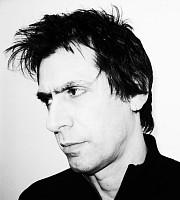Patrick Altes is a UK-based French-Algerian artist with a highly nuanced and sophisticated understanding of the word ‘Tolerance’, the title for his latest solo exhibition currently taking place at Gerald Moore Gallery in South East London. Mostly, he uses the word in the geopolitical context to refer to the types of relationships that can be forged between different peoples, nations and civilisations; and, also, looking at the concept as an ethical value to be cultivated, akin to compassion and empathy or the golden rule to treat others as one would wish to be treated.
Advocating and rooting for tolerance Altes challenges narratives that demean, debase or dehumanise ‘the other’ and bravely calls out some of the underlying racism, bigotry, resentment and intolerance that exist in our splintered world today. In so doing, he questions Eurocentric post-colonial discourse, feuding between religions, the worrying current trends towards far right politics and nationalism in Europe and the United States, the deep divisions that have been created by Brexit in the UK as well as tackling the negative attitudes towards migrants.
Born in Oran, Algeria in 1957 into a family of French-Spanish descent – they had lived in Algeria for three generations before leaving just prior to independence in 1962 – Altes was always keen to examine the complex and sensitive relationship between the country of his birth and that of France, the country in which he grew up. Not content with the view that excused French dominance and didn’t acknowledge the wrongs that were wrought upon the colonised people, he points out that there are consequences to that historical chapter that need heeding in order to mitigate the existing tensions between the two people.
In conversation with Nahla Ink, Altes said: “The French invaded Algeria for 130 years and did some pretty terrible things there, that were definitely not right; but, at the end of the day, we share a common history and common language that can be used to bring the countries together. It is important to me that this kind of antagonism between France and Algeria stops; and I quite like the idea of mending the links and building bridges between them.”
Another life experience that hugely influenced Altes was his stay in South Africa between 1981-1983. It was at the height of apartheid and he was teaching French in the University of Fort Hare, where a number of African National Congress members had gone to do their studies, including Govan Mbeki, Oliver Tambo and Nelson Mandela.
Altes: “It was a hot place of radicalism and an eye opener. I was a bit of a political person before, but this experience was something that showed me that politics really is the fabric of society and the fabric of life that you can’t live without. It is why I became interested in the plight of people. I also met many artists in SA and realised I enjoyed being in their company.”
Originally self-taught as an artist Altes then spent six years in Ecuador before returning to France and taking his training further. He enrolled in external life drawing classes of the Beaux Arts in Toulouse and undertook etching workshops for a couple of years, before coming to the UK in 2006 to take an MA in Fine Arts at the University of Brighton. Most recently, in 2012, Altes completed an Leverhulme Trust Arts residency at the University of Portsmouth. He is now based in St Leonards-on-Sea in Hastings where he has been living for the past seven years.
Typically exploring themes of identity, history and politics, Altes said: “You always put something of yourself in your work, it is about you and how you relate to the world. To me, art is a dialogue with people and a way of talking about identity, in the sense that it gives me an idea of where I stand in terms of my work and position in life, society, my political ideas and social ideas. It is almost like a manifesto all the time but not really at the same time.”
‘Tolerance’ Paintings & Signature Technique
Truly a grand solo show, there are altogether 70-plus pieces displayed on the walls over the two floors at the gallery. Some works date back to 2004, whilst others have been newly created, many specifically for the exhibition. They have been organised so that the ground level gallery features paintings and the top level holds the digital prints and collages.
One set of paintings that stands out due to their dark-heavy tones and disturbing imagery, tackles the subject of the Second Gulf War in 2003 and how the US channelled cleverly edited news commercials that became “almost pleasurable to watch” but completely covered up the cost of war on the Iraqis and the horrors they endured. One sees soldiers near to skulls and defaced humans coming out of TV monitors, relaying the artist’s take on the dangers of American war propaganda.
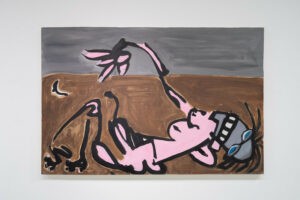
Coming close up to the works, one also discovers Altes’s signature layering technique. Beginning with the notion that the canvas is more like a wall, he can then write on it, scratch it, blend it with paper or paint over it. One good example is ‘The Hanging Gardens of England’, a three piece set where one can decipher the graffiti in the background- with the words ‘democracy’, ‘tolerance’, ‘freedom’ and ‘Stephen Lawrence’ – in contrast to the top painted image of pretty little flowers in the British flag colours of white, red and blue.
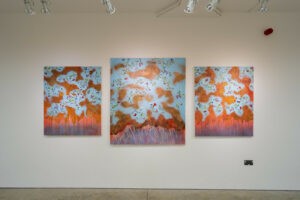
About these, Altes said: “I created something similar to an earlier work called ‘Hanging Gardens of Babylon’ that first challenged post-colonial narratives with a bit of irony. In this set you start with the graffiti that refers to Stephen Lawrence who was murdered in nearby Eltham in 1993 and then you see the overlaid pictures with the flowers. It is a way to express how sometimes you can hide underneath beauty and you can hide the reality that is a bit less beautiful.”
He also explained: “We live in polarised times where nationalism is becoming strong again and I believe it is time for people to take a step back and realise that we are all living on one planet and that the main problems are maybe not between nations but at the global level and our survival on the planet. We need to talk to each other regardless of differences of opinion.
“We have seen this with Brexit too, as the Brexiteers hate the Remainers and vice versa. At the end of the day, England will go one way or another but we will still be living in the same country. The idea is not to agree on everything but to listen to the other person, agree to disagree but have both opinions expressed. If we then go beyond that, the highest form of tolerance is love!”
Distinctive of the artist’s practice too are his roughly drawn figures that represent human beings and other recurring shapes like that of fish, pelicans and snakes. About these playful bodies and the animals, he said: “These are my way of representing people in all their quirks and differences, and yet showing we are all the same. They relate to the archetypical shapes that I have in my mind and conscience.”
Another significant group of paintings have been inspired by the hopscotch children’s game, offering a message about destiny. With a reference to the artist’s Catholic upbringing – the state of always being between earth, heaven and purgatory – and a line that signifies a mysterious link between the conscious and the unconscious, fate is seen to be beyond one’s power and control; wherein the weight of one’s family and country of birth, for example, influence who we become and what we might believe in.
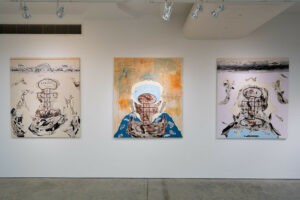
On the other hand, the hopscotch works as a metaphor for the cultivation of higher values and the potential to evolve beyond basic human instincts – that are usually tribal, hating, distrustful of others and seeing the world as the enemy to be feared – to acquire a higher state of being.
Digital Prints & ‘The Ultimate Mediation’
Upstairs the digital prints and collages reflect a unity in terms of colours and many seem to elaborate on the theme of the futility of conflict or the uselessness of holding grudges and resentments, as humanity must change and progress over the millennia. It is to point out also that empires, no matter how powerful or menacing, must all come and go or rise and then fall.
In ‘Ultimate Mediation’, for example, Altes makes a reference to the Mexican and Druid tradition of the ‘Day of the Dead’ and employs the icons of the three Abrahamic faiths of the cross, star of David and Muslim crescent. He said: “I quite like the idea that for one day, the spiritual world and the real world mix together. So whilst we think about the conflict of religions, this kind of succession of life and death or the cycle of life and death from the beginning of time is probably something more important.
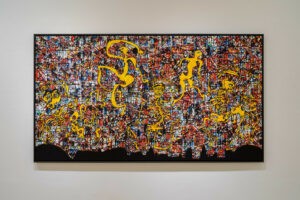
“I am trying to also talk about how these conflicts are actually not that important if you look at the bigger picture. Monotheistic religions -whether Catholic, Jewish or Muslim – are a relatively recent phenomenon and in view of what humanity has been through, they are not insignificant, but they don’t deserve to be fought over; in the sense that they should be bringing love and harmony rather than anything else.”
Another wall considers the concept of ‘fundamental British values’ with the display of colourful amateur drawings made – not by Altes but by vocational students at the East Sussex College in Eastbourne and the East Sussex College in Hastings. These were the interesting result of workshops recently conducted by Altes to help the schools fulfil their Ofsted obligations to familiarise the students with the meaning of these terms.
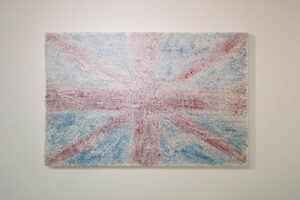
He said: “These values for me mean the respect for democracy, respect for personal freedom, right to your own sexuality, right to your own religion or absence of religion, and tolerance. I would in fact rather have them be called fundamental human values.”
The Installations: On Migration & Crossings
Last but not least, two powerful installations deal with the current plight of the African migrants who have been crossing the seas and enduring suicidal journeys in the faint hope of landing on European shores. One is set up poignantly with uprooted dead trees, blood stained trunks and broken branches coming out of travel cases, with little delicate potted green palms trees placed nearby.
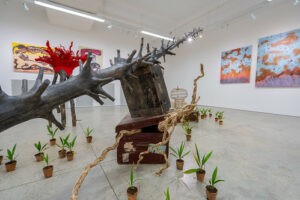
On this piece, Altes said: “Behind the word ‘migrants’ are real people who often don’t want to come to England or France, but have been driven by circumstances beyond their decision level. If anything they have been cut off from their environment and the uprooting is a bloody and dangerous process. Whilst the little plants here symbolise that once people have moved to a new place, they try to recreate, however fragile this is, a life of their own; and that, by so doing, they contribute to their host country.”
Whilst the second installation called ‘The Crossing’ features a rudderless wooden boat that looks more like a raft made out of driftwood. Placed in the middle of an Africa (that is represented by a wooden statue) and a Britain (represented by a teapot painted with the Union Jack), it seems to be lost at sea and unable to move in any one direction. And around this too are little clay pots filled with different coloured soils which Altes has collected throughout his travels.
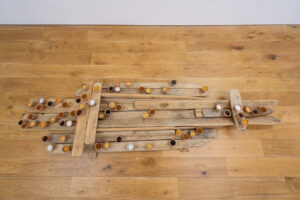
Altes: “I’ve tried to show that the people on these boats don’t choose the trip in the way that you might choose to go to France tomorrow for a visit. There is something a bit more primal and more difficult for them, as they can end up as floating and drowning bodies. Again the clay pots show how easily things can break and crumble whereas the soil represents the little something that one may find essential to take on a long journey as a reminder of home.”
In terms of the wider conversation on migration, Altes pointed out: “The world is founded on migration as we can trace the origin of humanity to Eastern Africa. Migration I believe can be seen either as a threat to identity or as a way to enrich identity; and, actually, you fear what you don’t know. So once you are exposed to the other, the fear disappears and you realise you are not that different; and, indeed, that the real differences that exist are quite interesting and make life better.”
The Fragile Flower
Marking the end of our interview, I asked Altes what would be the main message he would like for people to take with them when they come and visit. He robustly replied: “Tolerance to me is a fragile flower that has to be tended, cherished and exercised; in the sense that you have to be tolerant, otherwise there is the danger that it can decrease or even disappear. So we have to be vigilant about that.
“Also, I have created works that are ambiguous in nature so that people can superimpose their own narrative on the one I intended, either very consciously or not so consciously!”
Curated by Janet Rady Fine Art and supported by the Arts Council, ‘Tolerance’ is on until 25 January, 2020 at Gerald Moore Gallery, Mottingham Lane, London SE9 4RW.
Encompassing outreach and public engagement activities, school pupils and the public will be encouraged to reflect on values and ideas, bringing concepts such as the rule of law, diversity, democracy and individual liberty into the conversation.
There will also be a free panel discussion on 11 January 2020 at 2pm on ‘Tolerance, Migration and Identity’ with the artist Patrick Altes, writer and broadcaster Nadene Ghouri and writer and black British historian S I Martin.
For more on Patrick Altes: http://patrickaltes.com/
For more on Janet Rady Fine Art: https://www.janetradyfineart.com/
For more on Gerald Moore Gallery: https://geraldmooregallery.org/
